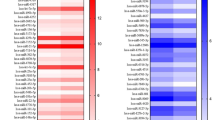Abstract
Understanding the function and regulatory mechanism of miR-140-3p on the osteogenic differentiation of bone mesenchymal stem cells (BMSCs). Alizarin Red staining, Alkaline phosphatase (ALP) staining, and ALP activity were used to detect the ability osteogenic differentiation. miR-140-3p or Spred2 overexpression into BMSCs using lentiviral vectors and the result were analyzed by Reverse transcription quantitative polymerase chain reaction (RT-qPCR). The relation between miR-140-3p and Spred2 was examined by luciferase reporter assay. CCK8 assay was used to detect the proliferation of BMSCs. RT-qPCR and Western blot analysis were both used to detect altered gene and protein in osteogenic differentiation of BMSCs, respectively. The BMSCs which were induced for 21 days were analyzed by Alizarin Red staining, (ALP) staining and ALP activity. RT-qPCR analysis showed that overexpressed miR-140-3p promotes osteogenic differentiation. Western blots results indicated that the overexpression of Spred2 suppressed miR-140-3p. Luciferase reporter assay indicated that Spred2 can integrate with miR-140-3p directly. Meanwhile, the protein level of ALP, OCN, and Runx2, the markers of chondrogenesis, was increased when miR-140-3p increased or Spred2 overexpressed in the osteoinductive medium applied to the BMSCs. Our study demonstrated the association between miR-140-3p and Spred2 in osteogenic differentiation of BMSCs for the first time. Furthermore, our detections also revealed that Spred2-induced autophagic signaling accelerates the progress of osteogenic differentiation ability of BMSCs.





Similar content being viewed by others
References
Matzkin EG, DeMaio M, Charles JF, Franklin CC (2019) Diagnosis and treatment of osteoporosis: what orthopaedic surgeons need to know. J Am Acad Orthop Surg 27(20):e902–e912
Murphy MB, Moncivais K, Caplan AI (2013) Mesenchymal stem cells: environmentally responsive therapeutics for regenerative medicine. Exp Mol Med 45:e54
Ohishi M, Schipani E (2010) Bone marrow mesenchymal stem cells. J Cell Biochem 109(2):277–282
Inada M, Yasui T, Nomura S, Miyake S, Deguchi K et al (1999) Maturational disturbance of chondrocytes in Cbfa1-deficient mice. Dev Dyn 214(4):279–290
Enomoto H, Enomoto-Iwamoto M, Iwamoto M, Nomura S, Himeno M (2000) Cbfa1 is a positive regulatory factor in chondrocyte maturation. J Biol Chem 275(12):8695–8702
Fan QM, Yue B, Bian ZY, Xu WT, Tu B (2012) The CREB-Smad6-Runx2 axis contributes to the impaired osteogenesis potential of bone marrow stromal cells in fibrous dysplasia of bone. J Pathol 228(1):45–55
Qiao Q, Xu X, Song Y, Song S, Zhu W (2018) Semaphorin 3A promotes osteogenic differentiation of BMSC from type 2 diabetes mellitus rats. J Mol Histol 49(4):369–376
Zhao Y, Samal E, Srivastava D (2005) Serum response factor regulates a muscle-specific microRNA that targets Hand2 during cardiogenesis. Nature 436(7048):214–220
Chen C, Cheng P, Xie H, Zhou HD, Wu XP (2014) miR-503 regulates osteoclastogenesis via targeting RANK. J Bone Miner Res 29(2):338–347
Ambros V (2004) The functions of animal microRNAs. Nature 431(7006):350–355
Li H, Li T, Wang S, Wei J, Fan J (2013) miR-17-5p and miR-106a are involved in the balance between osteogenic and adipogenic differentiation of adipose-derived mesenchymal stem cells. Stem Cell Res 10(3):313–324
Sun Y, Xu L, Huang S, Hou Y, Liu Y (2015) miR-21 overexpressing mesenchymal stem cells accelerate fracture healing in a rat closed femur fracture model. Biomed Res Int 2105:412327
Sun DG, Xin BC, Wu D, Zhou L, Wu HB, Gong W (2017) miR-140-3p-5p-mediated regulation of the proliferation and differentiation of human dental pulp stem cells occurs through the lipopolysaccharide/toll-like receptor 4 signaling pathway. Eur J Oral Sci 125(6):419–425
Jiang K, Liu M, Lin G, Mao B, Cheng W (2016) Tumor suppressor Spred2 interaction with LC3 promotes autophagosome maturation and induces autophagy-dependent cell death. Oncotarget 7(18):25652–25667
Peng W, Li J, Chen R, Gu Q, Yang P et al (2019) Upregulated METTL3 promotes metastasis of colorectal cancer via miR-1246/SPRED2/MAPK signaling pathway. J Exp Clin Cancer Res 38(1):393
Xie C, Liu S, Wu B, Zhao Y, Chen B et al (2020) miR-19 promotes cell proliferation, invasion, migration, and EMT by inhibiting SPRED2-mediated autophagy in osteosarcoma cells. Cell Transplant 29:963689720962460
Gharibi B, Cama G, Capurro M, Thompson I, De S (2013) Gene expression responses to mechanical stimulation of mesenchymal stem cells seeded on calcium phosphate cement. Tissue Eng A 19(21–22):2426–2438
Bundschu K, Knobeloch KP, Ullrich M, Schinke T, Amling M (2005) Gene disruption of Spred-2 causes dwarfism. J Biol Chem 280(31):28572–28580
Festa BP, Chen Z, Berquez M, Debaix H, Tokonami N (2018) Impaired autophagy bridges lysosomal storage disease and epithelial dysfunction in the kidney. Nat Commun 9(1):161
Choi J, Jo M, Lee E, Kim HJ, Choi D (2014) Differential induction of autophagy by mTOR is associated with abnormal apoptosis in ovarian endometriotic cysts. Mol Hum Reprod 20(4):309–317
Ullrich M, Bundschu K, Benz PM, Abesser M, Freudinger R (2011) Identification of SPRED2 (sprouty-related protein with EVH1 domain 2) as a negative regulator of the hypothalamic-pituitary-adrenal axis. J Biol Chem 286(11):9477–9488
Jiang K, Liu M, Lin G, Mao B, Cheng W et al (2016) Tumor suppressor Spred2 interaction with LC3 promotes autophagosome maturation and induces autophagy-dependent cell death. Oncotarget 7(18):25652–25667
Acknowledgements
This study was supported by Science and Technology Development Research Project in Shanxi province (Grant No. 2010R034-2).
Author information
Authors and Affiliations
Corresponding author
Ethics declarations
Conflict of interest
The authors declare that they have no competing interests.
Consent for publication
Not applicable.
Additional information
Publisher's Note
Springer Nature remains neutral with regard to jurisdictional claims in published maps and institutional affiliations.
Rights and permissions
About this article
Cite this article
Liu, P., Zhuang, Y., Zhang, B. et al. miR-140-3p regulates the osteogenic differentiation ability of bone marrow mesenchymal stem cells by targeting spred2-mediated autophagy. Mol Cell Biochem 476, 4277–4285 (2021). https://doi.org/10.1007/s11010-021-04148-8
Received:
Accepted:
Published:
Issue Date:
DOI: https://doi.org/10.1007/s11010-021-04148-8




